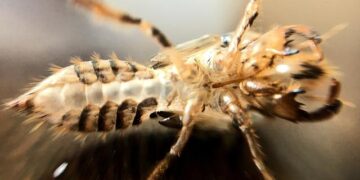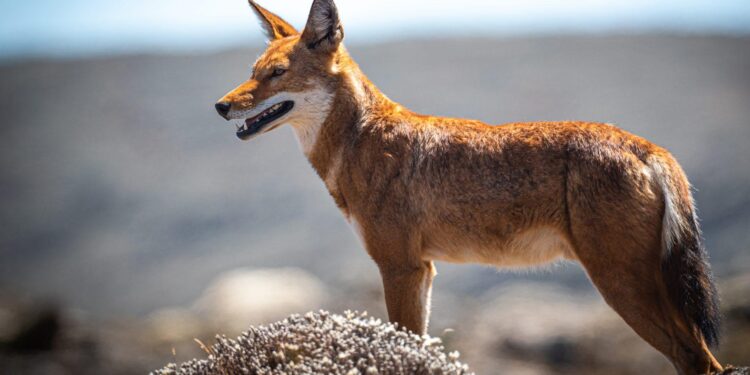In a surprising twist to the tale of plant-pollinator relationships, researchers have uncovered evidence that Ethiopian wolves-typically known as elusive carnivores-may play an unexpected role in the pollination of local flora. A recent study published in ESA Journals reveals that these rare canids forage for nectar from Kniphofia foliosa, a vibrant endemic flower, potentially aiding in its reproduction. This discovery not only challenges conventional wisdom about pollination but also highlights the intricate ecological connections in Ethiopia’s highlands, where even predators contribute to the survival of plant species.
Ethiopian Wolves Discovered Foraging Nectar Potentially Aiding Kniphofia foliosa Pollination
Recent observations have unveiled a surprising ecological interaction between the endangered Ethiopian wolf (Canis simensis) and the endemic flowering plant Kniphofia foliosa. Typically known as carnivorous hunters, these canids have been seen engaging in nectar foraging behavior-an activity previously undocumented in wild wolf populations. Researchers recorded multiple instances where wolves licked the nectar-rich flowers during dawn and dusk, likely attracted by the blossoms’ vibrant color and sweet scent. This mutualistic relationship suggests that Ethiopian wolves may play a previously unrecognized role in the reproductive success of K. foliosa, potentially aiding in its pollination process through incidental pollen transfer.
The implications of this finding extend beyond a simple case of foraging behavior. Key insights include:
- Pollination dynamics: Wolves’ fur and muzzles can trap pollen grains, supporting cross-pollination as they move between flowers.
- Conservation synergy: Protecting Ethiopian wolves might also preserve Kniphofia foliosa populations, highlighting ecosystem interdependence.
- Behavioral adaptation: Nectar foraging may represent a novel foraging strategy to supplement the wolves’ energy intake in resource-scarce environments.
| Aspect | Observation |
|---|---|
| Peak Nectar Foraging Time | Dusk and dawn |
| Pollination Mechanism | Pollen transfer via muzzle and fur |
| Frequency of Visits | 3-5 visits per evening per individual |
| Location | Ethiopian Highlands, Bale Mountains |
Unveiling the Unexpected Role of Canids in Ecosystem Dynamics and Plant Reproduction
Recent observations have shed light on an astonishing ecological interaction between Ethiopian wolves (Canis simensis) and the striking red-orange flowers of Kniphofia foliosa. Traditionally viewed solely as carnivores, these canids have been documented engaging in nectar foraging behavior, potentially acting as inadvertent pollinators. As the wolves lap nectar with their tongues, pollen adheres to their fur, facilitating pollen transfer between flowers. This unexpected behavior challenges conventional assumptions about pollination networks and highlights the multifaceted roles predators can play in ecosystem dynamics.
Key findings from this study include:
- The frequency of Ethiopian wolves visiting Kniphofia foliosa flowers peaks during early morning when nectar concentration is highest.
- Pollen samples collected from wolf fur matched the floral species, indicating effective pollen transport.
- These interactions may enhance genetic diversity within plant populations by connecting isolated floral clusters.
| Behavior | Observation Time | Pollination Impact |
|---|---|---|
| Nectar licking | 06:00 – 08:00 AM | High pollen transfer |
| Flower sniffing | Various | Low pollen contact |
| Grooming post-foraging | 08:00 – 09:00 AM | Reduces pollen load |
Conservation Strategies Must Consider Pollination Contributions of Ethiopian Wolves to Protect Biodiversity
Recent observations have unveiled an unexpected ecological role for the Ethiopian wolf (Canis simensis), traditionally known solely as an apex predator. Researchers have documented these canids engaging in nectar foraging on Kniphofia foliosa, a native flowering plant endemic to the Ethiopian highlands. This behavior suggests that Ethiopian wolves may serve as incidental pollinators, contributing to the reproductive success of these unique flora. As they feed on nectar, pollen adheres to their fur and is transported between flowers, fostering genetic diversity and ecosystem resilience. This discovery challenges conventional assumptions about pollination agents and highlights the complexity of interspecies interactions in fragile montane environments.
Integrating this newfound ecological service into conservation plans could be pivotal for protecting both the Ethiopian wolf and the floral communities they inadvertently support. Conservationists should consider the following strategic actions:
- Habitat preservation: Safeguard the flowering zones where nectar foraging occurs to maintain plant-wolf interactions.
- Community engagement: Promote awareness programs highlighting the wolf’s dual role as predator and pollinator.
- Research expansion: Encourage longitudinal studies to quantify pollination effectiveness and seasonal dynamics.
- Policy integration: Include pollination roles in species recovery and land management initiatives.
Such multifaceted approaches could enhance biodiversity conservation by recognizing canids not only as hunters but also as contributors to ecosystem services previously attributed mainly to insects and birds.
| Aspect | Role of Ethiopian Wolves | Conservation Implication |
|---|---|---|
| Nectar Foraging | Pollination agent for Kniphofia foliosa | Protect foraging habitats and floral diversity |
| Predation | Population control of small mammals | Maintain ecosystem balance |
| Human-Wildlife Interaction | Potential conflict and cultural value | Promote coexistence through education |
The Way Forward
The unexpected role of Ethiopian wolves in pollinating Kniphofia foliosa opens new avenues for understanding canid behavior and ecosystem dynamics. As these elusive carnivores forage for nectar, they may inadvertently support the reproduction of native plants, highlighting a complex interaction previously overlooked. This discovery not only challenges traditional views of pollination but also emphasizes the importance of conserving these vulnerable wolves and their habitats. Future research will be crucial to unravel the full ecological impact of this rare relationship, shedding light on how even top predators can contribute to the delicate balance of nature.































